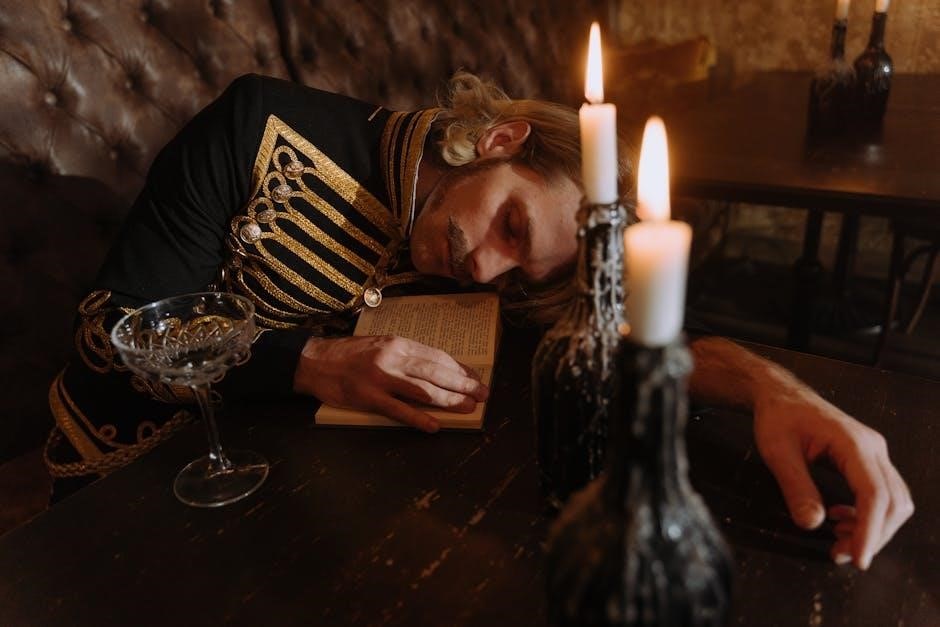Night by Elie Wiesel is a haunting memoir chronicling the author’s harrowing Holocaust experiences. First published in 1956, it remains a powerful exploration of faith, loss, and survival, offering a deeply personal account of one of history’s darkest periods.
1.1 Overview of the Book
Night by Elie Wiesel is a memoir recounting the author’s harrowing experiences during the Holocaust. Published in 1956, it chronicles Wiesel’s journey from his hometown of Sighet, Romania, through the horrors of Auschwitz and Buchenwald. The book explores themes of faith, survival, and the dehumanizing effects of extreme oppression. Wiesel’s vivid storytelling and emotional depth make Night a powerful and poignant account of one of history’s darkest periods, ensuring its place as a seminal work in Holocaust literature.
1.2 Importance of the Memoir
Night holds profound significance as a Holocaust memoir, offering a deeply personal and historical account of survival and suffering. It serves as a crucial educational tool, fostering understanding of the Holocaust’s atrocities and promoting tolerance. Wiesel’s narrative captures the emotional and psychological toll of genocide, providing insights into the human spirit’s resilience. Its inclusion in school curriculums ensures future generations learn from these events. The memoir’s impact extends beyond literature, as it preserves the stories of victims and survivors, making it an essential piece of historical documentation.
1.3 Historical Context of the Holocaust
The Holocaust, a genocide during World War II, saw six million Jews systematically murdered by the Nazis. Night is set against this backdrop, detailing Elie Wiesel’s experiences in Auschwitz and Buchenwald. The memoir highlights the Nazi regime’s brutality, forced labor camps, and mass exterminations. It underscores the invasion of Hungary in 1944, the deportation of Jews, and the liberation by Allied forces. Wiesel’s account provides a personal lens through which the scale and horror of the Holocaust are understood, making it a vital historical document of this tragic era.

Plot Summary of “Night”
Night by Elie Wiesel recounts Eliezer’s harrowing Holocaust journey. From Sighet to Auschwitz and Buchenwald, the memoir chronicles deportation, family separation, and the struggle to survive, ending with liberation.
2.1 Setting: Sighet, Auschwitz, and Buchenwald
The memoir Night unfolds in the towns and concentration camps of Eastern Europe during World War II. The story begins in Sighet, a peaceful town in Transylvania, where Elie Wiesel spends his early years immersed in religious studies. The tranquility of Sighet is shattered when the Nazis invade Hungary, leading to the deportation of Elie and his family. The setting shifts to Auschwitz, where the horrors of the Holocaust are starkly evident, and later to Buchenwald, the final camp where Elie faces the ultimate test of survival. These locations symbolize the progression from innocence to unimaginable despair.
2.2 Main Character: Eliezer (Elie) Wiesel
Eliezer, commonly referred to as Elie, is the protagonist and narrator of Night. A young, devout Jewish boy from Sighet, Elie is deeply immersed in religious studies and traditions. His journey through the Holocaust forces him to confront unimaginable horrors, leading to a profound crisis of faith. Throughout the memoir, Elie evolves from an innocent, spiritual youth to a survivor grappling with the moral and emotional scars of the concentration camps. His voice serves as both a personal account and a universal testament to the Holocaust’s impact on humanity.
2.3 Key Events: Deportation, Separation, and Survival
The memoir begins with the deportation of Elie and his family from Sighet to Auschwitz. Packed into cattle cars, they endure unimaginable conditions, with Madame Schächter’s screams foreshadowing the horrors ahead. Upon arrival, Elie is separated from his mother and sisters, never to see them again. The narrative follows his struggle to survive alongside his father, enduring forced labor, brutal beatings, and the death march to Buchenwald. The Holocaust’s atrocities test Elie’s faith and humanity, as he witnesses unimaginable cruelty and moral collapse. Liberation by American forces brings relief but leaves deep scars.

Themes in “Night”
Night explores themes of faith, loss, dehumanization, survival, hope, and despair, reflecting Elie Wiesel’s struggle with spirituality and humanity amidst the Holocaust’s unimaginable horrors and moral collapse.
3.1 Faith and Doubt
Elie Wiesel’s Night delves deeply into the theme of faith and doubt, chronicling his spiritual journey from devout belief to existential questioning amidst the Holocaust’s horrors. Initially, Elie’s strong connection to Judaism and his studies of the Cabbala provide him with a sense of purpose and meaning. However, the atrocities he witnesses, such as the hanging of a young boy and the mass burning of children, lead to a profound crisis of faith. He grapples with the idea of a benevolent God, feeling abandoned and questioning divine justice. This internal conflict is central to the memoir, as Elie’s faith is repeatedly tested by the unimaginable suffering and cruelty he endures. The Holocaust forces him to confront the silence of God, leading to a loss of spiritual innocence and a reevaluation of his beliefs.
3.2 Loss and Trauma
Loss and trauma are central themes in Night, as Elie Wiesel recounts the devastating impact of the Holocaust on individuals and communities. The memoir vividly portrays the loss of family, faith, and innocence, as Elie witnesses unbearable atrocities, including the separation from his mother and sisters and the eventual death of his father. The psychological toll of these events is profound, leaving Elie with a deep sense of despair and emotional scars that resonate long after liberation. The trauma of the Holocaust is depicted as irreversible, shaping Elie’s understanding of humanity and existence.
3.3 Dehumanization and the Holocaust
Night vividly illustrates the systematic dehumanization of Jewish people during the Holocaust. Elie Wiesel describes how victims were stripped of their identities, subjected to brutal treatment, and forced into inhumane conditions. The Nazis’ deliberate erosion of dignity and humanity is evident in the concentration camps, where prisoners were treated as mere numbers rather than people. This dehumanization not only destroyed lives but also left lasting psychological scars, emphasizing the atrocities committed and the loss of moral decency during this dark period in history.
3.4 Survival and Resilience
Night highlights the resilience of the human spirit amidst unimaginable horrors. Eliezer and his father endure extreme conditions, relying on each other for survival. Despite the brutal environment of the concentration camps, they find strength in their bond, even when faced with moral dilemmas like trading possessions for bread. The memoir underscores the psychological and physical challenges of survival, revealing how the will to live prevails even in the darkest moments. Their journey reflects the enduring capacity of humanity to persevere, even when hope seems lost.
3.5 Hope and Despair
Night explores the delicate balance between hope and despair in the face of atrocities. Eliezer clings to hope as a means of survival, yet grapples with its absence amidst unimaginable suffering. The memoir vividly portrays moments of fleeting hope, such as the arrival of liberation, contrasted with profound despair, as seen in the loss of faith and humanity. Through Eliezer’s journey, Wiesel illustrates how hope, though fragile, sustains the human spirit, even when despair threatens to consume it, leaving an indelible mark on the reader.

Character Analysis
Eliezer evolves from a devout boy to a questioning survivor, while his father embodies both strength and vulnerability. Madame Schächter symbolizes madness and truth, and Moché the Beadle serves as a spiritual guide, shaping Eliezer’s early faith and resilience.
4.1 Eliezer (Elie): The Protagonist
Eliezer, a young Jewish boy, is the emotional core of Night. His journey from devout faith to existential doubt mirrors the horrors of the Holocaust. Initially, Eliezer is deeply religious, studying Jewish texts and seeking spiritual guidance from Moché the Beadle. The Holocaust shatters his innocence, forcing him to confront unimaginable suffering. His relationship with his father becomes central, as they struggle to survive together. Eliezer’s internal conflict between hope and despair, as well as his questioning of God, defines his transformation from a naive boy to a scarred survivor.
4.2 Elie’s Father: A Symbol of Strength and Weakness
Elie’s father embodies both resilience and vulnerability. A respected figure in Sighet, he initially resists believing the Nazi threat, symbolizing communal denial. Throughout their ordeal, he remains Elie’s primary caregiver, sharing scarce resources and offering what little comfort he can. His physical decline in the camps contrasts with his earlier strength, illustrating the dehumanizing effects of the Holocaust. Despite his eventual weakness, he retains a paternal bond with Elie, representing a fading connection to their pre-war life and the enduring power of familial love amidst unimaginable horror.
4.3 Madame Schächter: A Symbol of Madness and Truth
Madame Schächter is a complex figure in Night, symbolizing both madness and truth. Her frantic screams about a fire on the deportation train are dismissed as delusions, yet her visions foreshadow the horrors of Auschwitz. Her breakdown reflects the psychological toll of the Holocaust, while her warnings, though ignored, carry a haunting truth. Through her character, Wiesel explores the fine line between sanity and insanity in the face of unimaginable atrocities, making her a poignant symbol of the Holocaust’s devastating impact on the human mind and spirit.
4.4 Moché the Beadle: The Spiritual Guide
Moché the Beadle is a pivotal figure in Night, serving as Eliezer’s spiritual mentor. He introduces the young boy to the mystical teachings of the Cabbala, fostering a deep connection to faith and tradition. After being expelled and witnessing atrocities, Moché returns to Sighet to warn the community about the Nazis, but his tales are dismissed as madness. His character symbolizes the tragic failure of foresight and the gradual erosion of spiritual guidance as the Holocaust unfolds, leaving Eliezer and others adrift in a world stripped of meaning and hope.

Historical Context of the Holocaust
The Holocaust was the systematic extermination of six million Jews during World War II, orchestrated by the Nazis. Night captures the horrors of this period, including the invasion of Hungary in 1944, which led to the mass deportation of Jews to concentration camps like Auschwitz and Buchenwald, marking a devastating chapter in human history.
5.1 The Invasion of Hungary in 1944
In 1944, Nazi Germany invaded Hungary, escalating the persecution of Hungarian Jews; Elie Wiesel’s hometown, Sighet, was occupied, leading to the deportation of its Jewish population. The invasion marked the beginning of a brutal period, as Jews were forced into ghettos and subsequently transported to concentration camps. This event was pivotal in the Holocaust, resulting in the deaths of over 400,000 Hungarian Jews. The invasion and its aftermath are vividly portrayed in Night, highlighting the systematic nature of the Nazi regime’s atrocities.
5.2 Auschwitz Concentration Camp
Auschwitz, one of the most infamous Nazi concentration camps, was a central location in Night. Elie Wiesel and his family were deported there in 1944. The camp was a symbol of the Holocaust’s brutality, where millions were murdered in gas chambers. Upon arrival, prisoners faced immediate separation, with those deemed unfit for labor sent to their deaths. Auschwitz’s harsh conditions, including forced labor and constant terror, are vividly depicted in Wiesel’s memoir, illustrating the dehumanizing atrocities committed during the Holocaust.
5.3 The Death March and Liberation
The death march, forced by retreating Nazis as Allied forces approached, subjected prisoners to brutal conditions. Thousands perished from exhaustion, cold, and violence during the harrowing journey to Gleiwitz and Buchenwald. Liberation by American forces in April 1945 marked the end of Eliezer’s ordeal, yet the trauma remained deeply etched. The march and liberation are pivotal in Night, highlighting the resilience of survivors and the devastating cost of freedom after unimaginable suffering.

Writing Style and Structure
Night is written as a memoir, blending vivid storytelling with poetic prose. Wiesel’s autobiographical account captures the emotional depth of his Holocaust experiences through concise yet powerful language, creating a deeply personal narrative that resonates universally.
6.1 Autobiographical vs. Semi-Fictional Narration
Night by Elie Wiesel is primarily an autobiographical account of his Holocaust experiences. However, scholars debate its semi-fictional elements, as some details blur fact and fiction. While based on real events, the narrative is crafted with literary techniques, leading some to classify it as a semi-fictional memoir. This blend of personal testimony and storytelling underscores its significant impact as both a historical document and a work of literature.
6.2 Use of Imagery and Symbolism
Night employs vivid imagery and symbolism to convey the horrors of the Holocaust. The recurring image of darkness symbolizes the moral and spiritual void, while flames represent destruction and the crematoria’s brutal reality. Elie Wiesel uses the train journey, shaved heads, and tattooed numbers as symbols of dehumanization. Madame Schächter’s screams and vision of fire foreshadow the atrocities, adding depth to the narrative. These elements create a haunting portrayal of the Holocaust, making the memoir a powerful exploration of human suffering and existential questioning.
6.3 The Impact of Language and Tone
Night’s profound impact stems from its direct, unflinching prose and somber tone. Wiesel’s simple yet powerful language creates vivid, haunting imagery, immersing readers in the atrocities of the Holocaust. The tone shifts from hopeful to despairing, reflecting Eliezer’s internal struggle with faith and humanity. Through sparse, evocative descriptions, Wiesel conveys the unimaginable horrors, making the narrative both deeply personal and universally resonant. This stylistic approach ensures the Holocaust’s lessons remain indelible, leaving readers with a lasting sense of moral urgency and reflection.

Impact and Legacy of “Night”
Night is a landmark Holocaust memoir, translated into thirty languages, widely studied in schools, and has had a profound cultural impact since its publication in 1958. It not only educated generations about the atrocities but also cemented Elie Wiesel’s legacy as a Nobel Peace Laureate and advocate for human rights.
7.1 Personal Impact on Elie Wiesel
Night profoundly impacted Elie Wiesel, serving as a therapeutic outlet to process his Holocaust trauma. Writing the memoir, initially in Yiddish, helped him confront his emotional wounds and grapple with his faith. The book’s publication in 1958 catapulted Wiesel to international prominence, establishing him as a voice for Holocaust survivors. It also laid the foundation for his advocacy work, leading to his Nobel Peace Prize in 1986. Through Night, Wiesel found purpose, transforming his suffering into a message of peace and justice.
7.2 Cultural and Historical Significance
Night holds immense cultural and historical significance as a firsthand account of the Holocaust, preserving the atrocities witnessed by Elie Wiesel. The memoir bridges personal narrative with broader historical context, offering a poignant perspective on one of humanity’s darkest chapters. Its vivid portrayal of concentration camps and the dehumanizing effects of genocide has educated millions, ensuring the Holocaust’s lessons are not forgotten. Translated into over 30 languages, Night remains a crucial resource for understanding the Holocaust’s impact on individuals and society, fostering empathy and remembrance globally.
7.3 Educational Value and Curriculum Inclusion
Night is widely integrated into educational curriculums for its profound educational value, offering students a personal and poignant account of the Holocaust. Its inclusion in school syllabi fosters empathy, historical understanding, and critical thinking about human rights and ethics. The memoir’s accessibility and emotional depth make it a vital teaching tool, while resources like SparkNotes and SuperSummary provide additional support for educators and students, enhancing comprehension and analysis of its themes and historical context.

Critical Reception and Reviews
Night has received widespread literary acclaim for its raw authenticity and emotional depth. A Nobel Peace Prize work, it has been translated into over 30 languages, impacting readers globally.
8.1 Initial Reception and Publication History
Night was first published in France in 1958 under the title La Nuit. The English translation, shortened for U.S. audiences, appeared in 1960. Initially, the memoir received modest attention but gradually gained acclaim for its raw emotional power. Critics praised its unflinching portrayal of Holocaust horrors, while some debated its classification as memoir or semi-fictional novel. The book became a cornerstone of Holocaust literature, resonating deeply with readers worldwide and earning Wiesel global recognition for his courageous storytelling.
8.2 Literary Criticism and Analysis
Night has been widely analyzed for its literary merit and emotional depth. Critics highlight its vivid imagery and symbolism, such as the recurring motif of fire, representing destruction and divine absence. Wiesel’s sparse yet powerful prose underscores the brutality of the Holocaust, creating a visceral connection with readers. Some scholars debate the memoir’s factuality versus its artistic elements, while others emphasize its psychological exploration of trauma and faith. The book’s ability to balance personal narrative with universal themes has solidified its place in literary history.
8.3 Comparisons to Other Holocaust Literature
Night is often compared to other Holocaust memoirs like Man’s Search for Meaning by Viktor Frankl and The Diary of Anne Frank. While Frankl’s work focuses on psychological resilience, Wiesel’s memoir delves into spiritual struggle and existential doubt. Anne Frank’s diary, though equally poignant, offers a more intimate, hopeful perspective before her deportation. Night stands out for its unflinching portrayal of concentration camp horrors and its exploration of faith’s disintegration. It is frequently regarded as one of the most impactful Holocaust narratives, alongside these classics, ensuring its enduring relevance.

Study Guides and Educational Resources
Study guides and educational resources for Night are widely available, offering detailed summaries, analysis, and teaching materials. Popular platforms include SparkNotes and SuperSummary.
9.1 SparkNotes and SuperSummary
SparkNotes and SuperSummary provide comprehensive study guides for Night, offering detailed summaries, chapter analyses, and thematic explorations. These resources are designed to help students understand the memoir’s complex themes, such as faith, loss, and survival. Both platforms include in-depth analyses of key characters like Eliezer and his father, as well as historical context about the Holocaust. Their user-friendly formats make them invaluable tools for classroom discussions and individual study, supporting a deeper engagement with Wiesel’s powerful narrative.
9.2 Teaching Guides and Discussion Questions
Teaching guides for Night are essential for educators, offering structured lesson plans and thought-provoking discussion questions. These resources help students engage with the memoir’s themes, such as faith and resilience, while fostering critical thinking. Questions often focus on Eliezer’s emotional journey, the impact of dehumanization, and the broader historical context. Additional materials include activities to promote empathy and understanding, making the Holocaust’s lessons relevant and accessible for modern students. These guides empower teachers to lead meaningful conversations about Wiesel’s profound narrative.
9.3 Themes and Quotes for Analysis
Night explores profound themes like faith, hope, and dehumanization. Key quotes, such as “He was weeping…for the first time, I felt revolt rise up in me,” highlight Eliezer’s spiritual struggle. The loss of innocence is evident when he states, “The night was gone. Eternal night.” These quotes provide rich material for analysis, allowing readers to delve into the psychological and emotional depths of Wiesel’s experience. They serve as a catalyst for discussions on humanity’s capacity for cruelty and resilience, making Night a pivotal text for studying the Holocaust’s impact.

Where to Access “Night” in PDF Format
Night in PDF can be accessed through legal sources like SparkNotes or SuperSummary. Ensure to download from authorized retailers or libraries to support the author and publishers ethically.
10.1 Legal and Ethical Considerations
Accessing Night in PDF requires adhering to copyright laws. Downloading from unauthorized sites is illegal and undermines authors’ rights. Ethically, supporting official sources ensures fair compensation to creators. Libraries and educational platforms often offer free or low-cost access, promoting legal and ethical consumption. Always verify the legitimacy of the source to avoid piracy and respect intellectual property rights. This ensures the continued availability of such important works for future generations.
10.2 Recommended Sources for Download
For a legal and ethical download of Night in PDF, consider reputable sources like official publisher websites, Amazon, or Google Books. Educational platforms such as SparkNotes or SuperSummary also offer digital versions. Libraries often provide free access through services like OverDrive. Additionally, eBookstores like Barnes & Noble or Kobo offer authorized downloads. Always verify the source’s legitimacy to ensure compliance with copyright laws and support the author’s work. These platforms provide safe and legal access to the book while respecting intellectual property rights.
10.3 Free vs. Paid Resources
Accessing Night in PDF can be done through both free and paid resources. Free options include borrowing from libraries or using platforms like Project Gutenberg, though availability may vary. Paid sources offer convenience and support authors, with options like Amazon Kindle or Google Play Books. Ensure free downloads are legal to avoid copyright infringement. Paid versions provide high-quality formatting and contribute to the author’s legacy, making them a responsible choice for readers seeking a reliable copy of this significant work.
Night by Elie Wiesel is a profound Holocaust memoir that leaves a lasting impact on readers. Its emotional depth and historical significance ensure its enduring relevance in understanding one of humanity’s darkest chapters.
11.1 Summary of Key Points
Night by Elie Wiesel is a poignant memoir detailing the Holocaust’s horrors through the author’s personal experiences. It explores themes of faith, loss, and survival, offering a raw account of life in Auschwitz and Buchenwald. The book’s historical significance lies in its unflinching portrayal of Nazi atrocities, making it a vital resource for understanding this dark period. Its emotional depth and literary impact have solidified its place in Holocaust literature, ensuring its relevance for future generations as a powerful educational tool.
11.2 Final Thoughts on the Book’s Significance
Night stands as a testament to human resilience and the enduring spirit of hope amidst unimaginable suffering. Elie Wiesel’s memoir is not just a historical account but a deeply personal journey of faith, doubt, and survival. Its significance lies in its ability to educate future generations about the Holocaust, ensuring that such atrocities are never forgotten. The book’s emotional and moral depth continues to inspire reflection, making it a crucial piece of literature for understanding humanity’s capacity for both cruelty and compassion. Its impact remains timeless and profound.